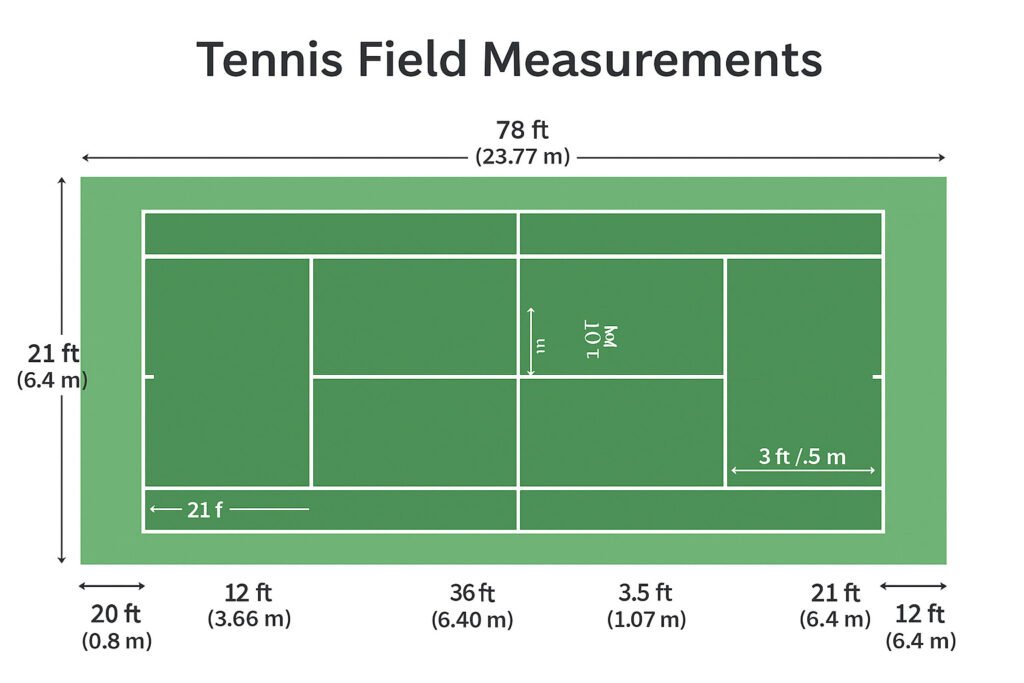Tennis Court Dimensions: Complete Guide to Tennis Field Measurements
A perfectly measured tennis court is the foundation of every great match — from local tournaments to international championships. Understanding tennis field measurements is essential for players, coaches, and court builders who aim to maintain professional standards. According to the International Tennis Federation (ITF), tennis court dimensions must be precise to ensure fairness, safety, and consistent gameplay across all surfaces — whether acrylic, clay, or grass. In this guide, we’ll break down the standard tennis court dimensions in feet and meters, including court length, width, service boxes, net height, and surrounding space. Whether you’re building a new tennis court or just curious about the layout, this article will help you understand every measurement that defines a regulation tennis field. Standard Tennis Court Dimensions A standard tennis court is designed according to precise measurements defined by the International Tennis Federation (ITF) to ensure uniformity across the world. Whether you’re playing a casual match or competing professionally, the court dimensions remain the same — only the width changes between singles and doubles play. Tennis Court Size in Feet and Meters This means that the total playing area is slightly wider for doubles matches to allow more space for team play. Additional Measurement Details The center mark divides the baseline in half and helps players position themselves accurately while serving. Total Area Including Runoff Space While the playing area is fixed, a minimum clear space around the court is essential for safety and free movement: This makes the total area of a standard tennis court approximately 120 feet (36.58 meters) long and 60 feet (18.29 meters) wide, including the run-off zones. ✅ Key Takeaway The standard tennis court dimensions ensure consistency, allowing players to adapt their skills easily on any certified court worldwide. Whether built for clubs, schools, or residential projects, following ITF-approved measurements guarantees a professional-quality playing experience. Service Boxes and Baseline Markings When it comes to tennis court layout, two of the most important components are the service boxes and baseline markings. These lines define the key playing zones where serves must land and where players position themselves during rallies. Understanding their exact measurements is crucial for maintaining an accurate and professional tennis field setup. 🎯 Service Boxes Dimensions A standard tennis court has two equal service boxes on each side of the net, divided by the center service line. These boxes determine where a serve must land to be considered valid. The center service line and center mark help players position their serves accurately, ensuring fair play on both sides. 🟨 Baseline and Center Mark The baseline runs parallel to the net and marks the farthest boundary at the back of the court. 📐 Purpose and Importance The precise alignment of service boxes and baselines ensures that every serve, rally, and point is judged accurately according to ITF tennis court standards. Even a small deviation in these measurements can affect gameplay and fairness, especially in professional matches. Net Height and Placement The tennis net is one of the most critical elements of a court’s design, serving as the central barrier that defines each side of the playing field. Maintaining the correct net height and placement ensures fairness, consistency, and compliance with ITF tennis court standards. 🎾 Standard Net Height Measurements According to the International Tennis Federation (ITF), the official tennis net height varies slightly between the posts and the center: This gentle downward curve is intentional — it ensures proper tension, allowing the ball to pass over the net realistically while maintaining uniform bounce behavior during play. 📏 Net Placement and Length The tennis net runs across the full width of the court, extending slightly beyond the sidelines for stability: Even on singles courts, the net posts remain in the same position, but singles sticks are used to narrow the playing width to 33 feet (10.06 meters), aligning with the singles court boundaries. ⚙️ Net Material and Tension A regulation tennis net is typically made from braided nylon or polyethylene mesh. Proper tensioning is vital — too tight, and the ball rebounds excessively; too loose, and the ball may sag or fall through. The center strap ensures consistent height and stability during matches. ✅ Why Correct Net Height Matters Maintaining the correct net height is essential for: Consistent net height and placement guarantee that the court performs the same way across all levels — from recreational to professional matches. Surrounding Areas (Runoff Space) When constructing a tennis court, it’s not just the playing surface that matters — the surrounding areas, also known as runoff space, play a major role in player safety, comfort, and overall game experience. Adequate runoff space ensures players can move freely and chase shots without the risk of injury or collisions with fences or walls. 🟩 Recommended Runoff Space Measurements According to ITF tennis court standards, a regulation tennis court must include clear space around the playing lines: This means the total area required for a full-sized tennis court, including runoff space, is approximately: These measurements create enough room for safe player movement and proper ball clearance, which are essential during competitive matches. ⚙️ Importance of Runoff Space The runoff area isn’t just for safety — it also affects gameplay quality and spectator experience. 🧱 Additional Considerations for Construction ✅ Why Runoff Space Matters Ignoring runoff space can lead to unsafe court conditions, especially in professional or high-speed play. By following ITF-approved tennis court layout standards, you can guarantee optimal performance, safety, and long-term durability of your facility. Tennis Court Layout for Different Levels While the standard tennis court dimensions remain consistent globally, the layout and size can vary depending on the level of play — from professional tournaments to school or junior matches. Understanding these variations helps builders and players design courts that suit different skill levels and age groups while still maintaining ITF tennis court standards. Professional Tennis Courts (ITF & ATP/WTA Standards) Professional courts follow strict International Tennis Federation (ITF) regulations to ensure uniformity and fairness across all competitions. These courts are




